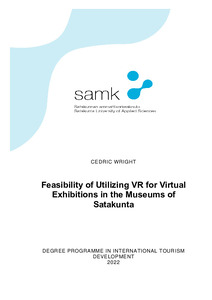Feasibility of Utilizing VR for Virtual Exhibitions in the Museums of Satakunta
Wright, Cedric (2022)
Wright, Cedric
2022
All rights reserved. This publication is copyrighted. You may download, display and print it for Your own personal use. Commercial use is prohibited.
Julkaisun pysyvä osoite on
https://urn.fi/URN:NBN:fi:amk-2022120827172
https://urn.fi/URN:NBN:fi:amk-2022120827172
Tiivistelmä
The virtual reality (VR) industry has been rapidly expanding in the last few years. While the consumer VR market has primarily been focused on gaming, VR has been utilized in a variety of different methods such as training for first responders and human resources, virtual car showrooms by several car manufacturers and office work in some companies. Recently, businesses in the tourism industry began utilizing VR as well. The aim of this thesis is to learn the potential of incorporating virtual reality hardware and software for use in virtual exhibitions for museums located in the Satakunta region of Finland.
This thesis takes a deep dive into the VR industry describing key concepts, VR history, current VR hardware and a look into how VR is currently utilized in tourism. Additionally, the thesis investigates the Satakunta region as a tourist destination with a focus on the museums in the area. This dive includes, among other things, a discussion of museum categories and notable museums in the region.
For collecting the empirical data, the qualitative research method was utilized. The author reached out to museum staff in the region to conduct semi-structured theme interviews. Three interviews have taken place during the course of preparing this thesis and content analysis was the primary method utilized for analyzing the data. Based off the interviews, challenges, best applied VR usage and feasibility of utilizing VR in virtual exhibits emerged as the themes after content analysis was complete.
The interviewees have expressed interest in utilizing VR for virtual exhibitions. However, each museum in question faces a different set of circumstances that would need to be worked through to support this endeavor.
This thesis takes a deep dive into the VR industry describing key concepts, VR history, current VR hardware and a look into how VR is currently utilized in tourism. Additionally, the thesis investigates the Satakunta region as a tourist destination with a focus on the museums in the area. This dive includes, among other things, a discussion of museum categories and notable museums in the region.
For collecting the empirical data, the qualitative research method was utilized. The author reached out to museum staff in the region to conduct semi-structured theme interviews. Three interviews have taken place during the course of preparing this thesis and content analysis was the primary method utilized for analyzing the data. Based off the interviews, challenges, best applied VR usage and feasibility of utilizing VR in virtual exhibits emerged as the themes after content analysis was complete.
The interviewees have expressed interest in utilizing VR for virtual exhibitions. However, each museum in question faces a different set of circumstances that would need to be worked through to support this endeavor.
